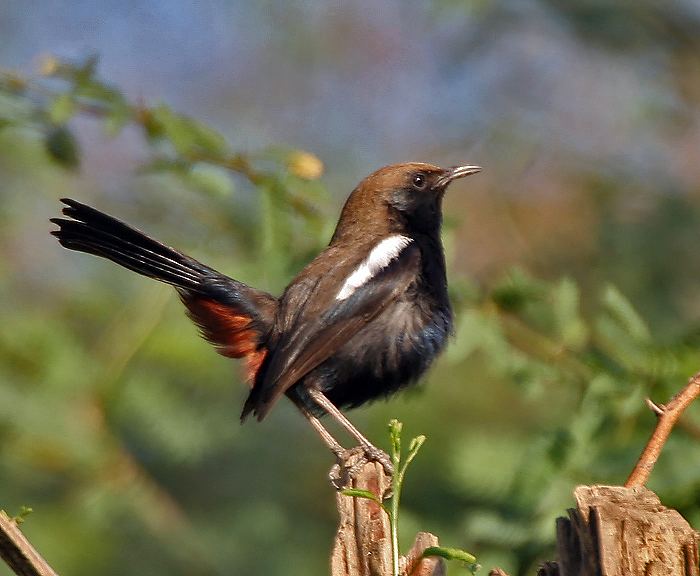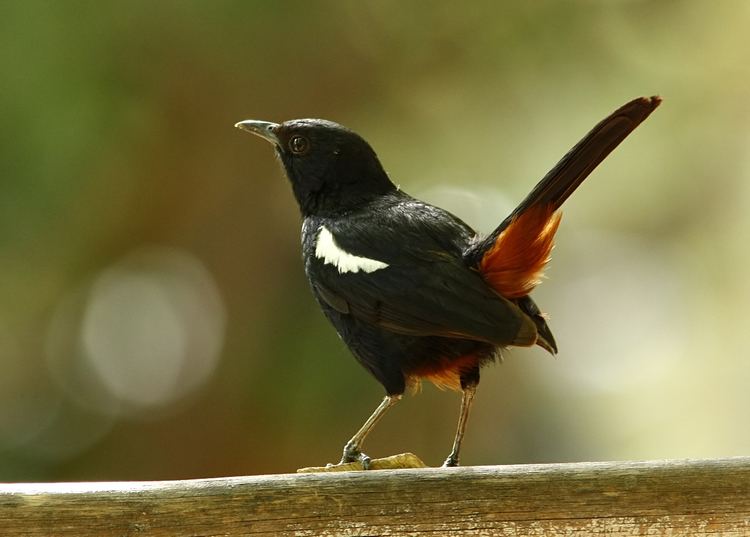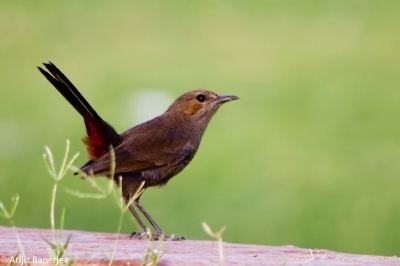Order Passeriformes Genus Copsychus Higher classification Saxicoloides | Phylum Chordata Family Muscicapidae Scientific name Saxicoloides fulicatus Rank Species | |
 | ||
Similar Pied bush chat, Brown rock chat, Indian blue robin, Purple sunbird, Ashy prinia | ||
The Indian robin (Copsychus fulicatus) is a species of bird in the family Muscicapidae. It is widespread in the Indian subcontinent, and ranges across Bangladesh, Bhutan, India, Nepal, Pakistan, and Sri Lanka. The males of northern populations have a brown back whose extent gradually reduces southwards with populations in the southern peninsula having an all black back. They are commonly found in open scrub areas and often seen running along the ground or perching on low thorny shrubs and rocks. Their long tails are held erect and their chestnut undertail covert and dark body make them easily distinguishable from the pied bushchat and the oriental magpie robin.
Contents
- Sweet compelling calls indian robin
- Taxonomy
- Description
- Distribution and habitat
- Ecology
- Food
- Breeding
- Parasites
- References

Sweet compelling calls indian robin
Taxonomy

The Indian robin was the only species in the monotypic genus Saxicoloides until it was moved to Copsychus based on the results of several molecular phylogenetic studies published since 2010.
Description

The Indian robin is sexually dimorphic in plumage with the male being mainly black with a white shoulder patch or stripe whose visible extent can vary with posture. The northern populations have the upper plumage brownish while the southern populations are black above. The males have chestnut undertail coverts and these are visible as the bird usually holds the 6–8 cm long tail raised upright. The females are brownish above, have no white shoulder stripe and are greyish below with the vent a paler shade of chestnut than the males. Birds of the northern populations are larger than those from southern India or Sri Lanka. Juvenile birds are much like females but the throat is mottled.

Several populations are named based on their plumage differences. The nominate subspecies refers to the population found across southern Peninsular India. Race leucopterus is found in Sri Lanka. Race cambaiensis of western India and erythrura (=erythrurus) of eastern India (south to around Sambalpur) have the males with brown backs. The population intermedius includes forms between cambaiensis, erythrura and fulicata in central India and parts of the Deccan region. A race munda was named on the basis of a specimen from Punjab but is now considered synonymous with cambaiensis. Older classifications treat the population in southern India under the name ptymatura while considering the type locality as Sri Lanka although the type locality has subsequently been restricted to Pondicherry.

Local names recorded by Jerdon include Nalanchi (Telugu), Wannatikuruvi (Tamil, Washerman bird), Kalchuri (Hindi) and Paan kiriththaa (Sinhala). The genus name indicates that it looks similar to Saxicola, the genus of the pied bushchat, a bird often found in similar habitats.
Distribution and habitat
This bird is found in open stony, grassy and scrub forest habitats. They are mainly found in dry habitats and are mostly absent from the thicker forest regions and high rainfall areas. All populations are resident and non-migratory. The species is often found close to human habitation and will frequently perch on rooftops.
The species was introduced into the New York region but did not establish. A vagrant or escape has been noted from the Maldives.
Ecology
Population densities of 193-240 individuals per square km have been estimated in the Pondicherry University campus. The ratio of males to females was about 1.5:1. Territory size for males is estimated at about 6650 m2. Males can be aggressive to others during the breeding season and will even attack reflections. Human activities such as felling and firewood removal in forests appear to benefit them.
Food
They feed mostly on insects but are known to take frogs and lizards especially when feeding young at the nest. Individuals may forage late in the evening to capture insects attracted to lights.
Breeding
The breeding season is December to September but varies according to region and usually begins with the first rains. Peak breeding in northern India is in June and is earlier in Southern India. In Sri Lanka it breeds in March to June and August to September. Males sing during this season and display by lowering and spreading their tail feathers and strutting around the female, displaying their sides and fluffing their undertail coverts. The songs of males have variants for inviting mates and for deterring other males. Males will drive away other males and patrol their territory by flying with slow wing-beats from perch to perch. They may sometimes peck at their reflections. An aggressive display involves fluffing up the feathers and holding the bill high.
Nests are built between rocks, in holes in walls or in a tree hollow. Nests are lined with animal hair and it has been noted that many nests have pieces of snake sloughs. The eggs are of regular oval form, but many are elongated and a few pointed. They have a fair amount of gloss. The ground-colour is white, often tinged with faint green or pink, and this is rather closely spotted, speckled, streaked, and mottled, with rich reddish or umber-brown and brownish yellow, with some underlying lavender. The markings are denser at the larger end of the egg, where they form an irregular cap. Some eggs are blotched with dark reddish brown at the large end. Eggs are about 0.76–0.84 inches (1.9–2.1 cm) long and 0.55–0.62 inches (1.4–1.6 cm) wide. Three to four eggs is the usual clutch. An abnormal clutch of seven has been noted although none of the eggs hatched at this nest. Only the female incubates. Eggs hatch in about 10–12 days. Chicks have black down. Both males and females feed the young, the males sometimes passing food to the female which in turn feeds the young. Nestlings may feign dead (thanatosis) when handled. Nestlings may be preyed on by the rufous treepie. The same nest site may be reused in subsequent years.
An old anecdotal record of these birds laying their eggs in the nests of Turdoides babblers has not been supported by later observers. Laboratory studies have demonstrated cyclic changes in the melanin pigmentation of the tissue surrounding the testes. The dark pigmentation is lost during the breeding season and regained later.
Parasites
Several parasites including a cestode have been identified in this species.
